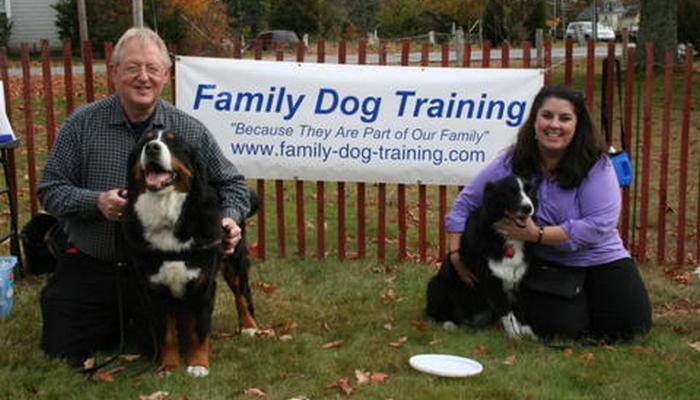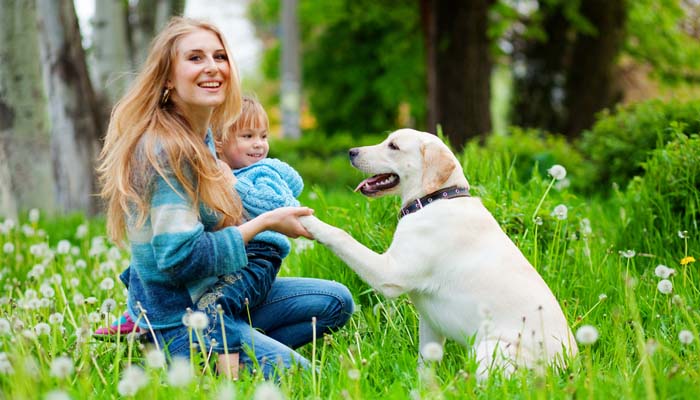Each week I get the opportunity to speak with an expert in the pet industry, and this week I was fortunate enough to have a conversation with Paul Emerson, CPDT-KA (Certified Pet Dog Trainer – Knowledge Assessed).
Paul is the co-founder of Family Dog Training, a positive, force-free dog training facility in Massachusetts. Paul has been working with dogs since 1977, which is when he purchased his first Bernese Mountain Dog.
I was surprised to find out that Paul didn't grow up with dogs. Typically people who work with dogs have been around them their entire lives. The passion for canines is instilled in them at a young age and they find a way to turn it into a career. Paul actually acquired his first dog as an adult.
Paul's story…
Paul Emerson began training dogs professionally in 1991, and founded Family Dog Training in 2008. When the exam to achieve the status of Certified Professional Dog Trainer was first offered in the fall of 2001, Paul was one of the first to pass it.
He keeps his certification active by participating in continuing education to stay current with the latest knowledge and skills in the dog training industry.
Paul is a former president of the Bernese Mountain Dog Club of Nashoba Valley (BMDCNV), which covers the New England states. He’s also a past rescue chair of the BMDCNV and was also the first draft work chairman of the Bernese Mountain Dog Club of America.
Currently, Paul is a professional member of the Association of Pet Dog Trainers, the training resource chair for the BMDCNV and has been a long-time Draft Judge for the Bernese Mountain Dog Club of America.
On top of all of this, he’s also an American Kennel Club Canine Good Citizen evaluator and a member of Truly Dog Friendly (TDF). TDF is a national organization that promotes non-violent training methods. He co-founded Family Dog Training with follow trainer Bridget Desroshes.
MUST READ: 10 Psychological Dog Training Tricks
Important Tips and Tricks for Family Dog Training

I wanted to jump into the conversation with Paul talking about kids and dogs. Because he works with so many families he sees a lot of different dynamics and he's had a lot of experience working together with dogs and children. It's important for families to be on the same page when bringing a dog into their home.
One of the best tips that Paul shared with me was to make sure that you have time for a dog if you're thinking of adopting one.
Oftentimes families don't realize the time commitment that a new dog will require. Depending on the ages of the children and the family's schedule, they may not have enough free time to devote to a dog.
If you're already complaining that your life is too busy, chances are you won't have time for a dog. If you want to adopt one, you'll need to sacrifice some of your previous commitments.
Families with children are typically very busy. There are school functions, sporting events and social commitments that they need to attend. Chances are the parents are already spending most of the day at work and the kids are probably gone to school for at least 8 hours.
All of this time spent away from home is not a good environment to bring a dog into. Paul told me that 8 hours is the absolute maximum that a dog should be left home in a dog crate or by himself. Anything more than that, and the dog is getting too much down time during the day.
This will either create a destructive dog or an overweight dog. Your dog needs activity throughout the day. If you're going to be gone for more than 8 hours, you should hire a dog walker, pet sitter or take your pup to daycare. If this isn't feasible for your budget, then it's probably not the right time for you to get a pet.
RELATED: Respect Your Fido – Humane Dog Training Equipment
Training Dogs With Children
If you're planning on making training your dog a family affair, and you really should, you need to consider the needs of both the child and the dog. Is the child going to be able to handle the dog on a leash? Chances are that a 7-year-old won't be able to hang onto a Newfoundland.
You also need to think about your child's ability level. Typically, Paul doesn't let children out on the floor to train a dog unless they are at least 12-years-old. Of course, sometimes a 9- or 10-year-old is capable of the job, but it depends on the child and the dog.
As we were talking about training dogs with children, Paul said something that really stood out to me. He said that children who learn to be responsible for a dog growing up understanding what it's like to be responsible for another living being as an adult.
Children who take part in raising the family dog learn empathy and compassion for others.
If you're debating on adopting a dog because you have children, think about all the positive things that your child will get out of the relationship. Children should help with every aspect of raising the dog, not just training. Depending on your child's age, they could be responsible for feeding the dog, brushing the dog or walking the dog.
Paul explained that if your child wants a dog, then they should be expected to be responsible for the dog to a certain degree. Of course, this will vary depending on your dog's age.
Paul told me that when children come to his training classes he allows them to be as involved as they are willing to be often. Often they participate for 10 or 15 minutes and then take a break.
More great advice videos:
Tips for Finding a Dog Trainer
First thing is first, don't wait too long! Paul explained to me that the longer a dog engages in an unwanted behavior, the more difficult it will be to train him that the behavior is not acceptable.
In all the years that he has been training, he says that there really aren't any behaviors that he feels you cannot correct, but the longer you wait the longer the training will take.
When searching for a dog trainer, Paul says to look at their credentials first. They should be a certified trainer and the more professional organizations they are a part of, the better. Also, ask for references. Any reputable trainer will be able to give you multiple references.
We also had a lengthy conversation about the training that is available at big box stores. The thing you need to remember is that training is just a very small aspect of the business. The company's main focus is selling pet products – training is just a convenience that they offer for their customers.
When it comes to training a dog, consistency is key. Working with one certified trainer is the best option.
It's much wiser to find a certified dog trainer. Training dogs is their main focus. That is the one thing that they put time and energy into, unlike big box stores that have many other things on their plate. The biggest issue with the big box stores is quality control.
If you find a certified trainer, like Paul, you're going to receive the same information and your dog will receive the same type of training each day when you come back. At big box stores, they hire multiple dog trainers and they will all have different views and opinions on the proper way to train a dog.
I'd like to take this time to thank Paul Emerson for speaking with me about dog training. Make sure you check out Family Dog Training for more information about training. They have a great resource list available for pet parents who aren't in the Massachusetts area.
READ NEXT: 16 Best Dogs for Families with Kids















